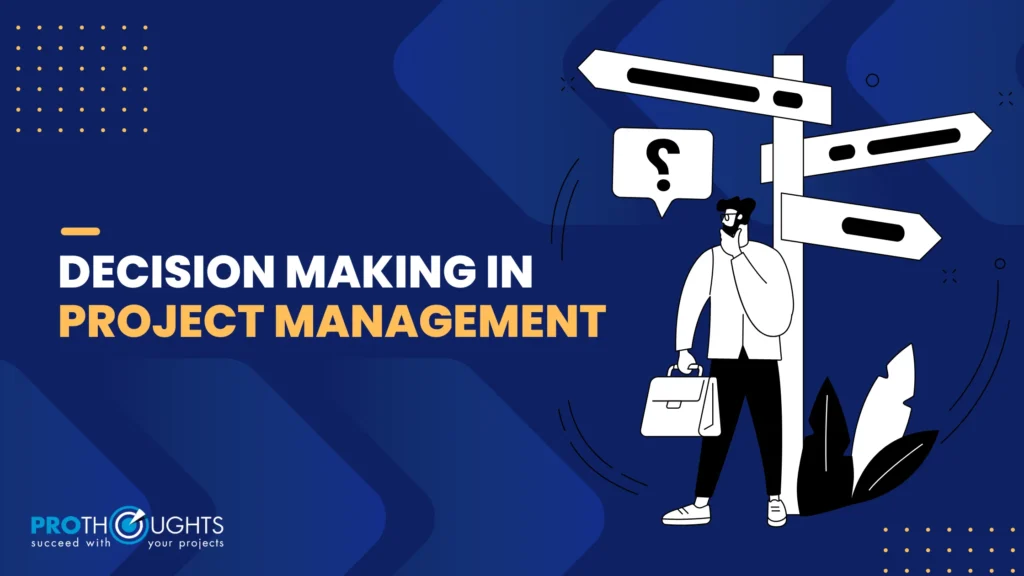
Making decisions is a basic skill of project management. While it is a tactical or routine operation, choosing the best course to take from a range of options to help the project achieve its goals will have an impact on the project’s success.
Moreover, from the management of timelines to the management of resources, decision-making in a project manager determines the project life cycle. As such, it is highly valued in PMP Certification programs and is essential in any Project Management Course.
Importance of Decision-Making in Project Management
It is vital to maintain that decision-making can be counted as one of the most essential parts of the project management framework. First and foremost, project management competency in decision-making at the right time and within the scope of available information is highly significant for project performance. Without a proper decision-making structure, projects can be easily delayed, face issues with their budgets, and expand beyond manageable size. Nevertheless, if decision-making is fruitful, it can reduce potential problems as it provides direction and solutions in moments that call for them. Finally, effective decision-making is crucial to monitor as it reflects the final stage of the project implementation.
A well-honed decision-making process brings numerous benefits:
- Saves time and resources: It becomes easier for a project manager to make the right decisions in the shortest time possible hence enhancing resource allocation and avoiding wastage.
- Mitigates risks: Where there is an early decision, then some potential problems characteristic of certain phases can be solved in advance and before they interfere with major processes of the project.
- Boosts team morale: This is true because when decisions are made in public and where everyone has a chance to have his say, then people develop a sense of belonging and are more inclined to have ownership of the final decision made.
- Enhances stakeholder confidence: Correct and logical decisions guarantee that stakeholders are informed on the progress of the project and what it seeks to achieve. Proper decision-making is used in the project to show that the project is in the right hands hence earning the trust of the people involved.
These benefits make decision-making indispensable, and mastering it is key for anyone pursuing a PMP Certification or an advanced Project Management Course.
Types of Decisions in Project Management
A variety of decisions must be made by project managers during the project. Three main groups can be used to classify these decisions:
1. Strategic Decisions
Tactical decisions have fewer consequences and are usually made more frequently than strategic ones and they define the general course of the project. It is strategic because they are strategic choices and this determines the overall project goals, project scope, and its relevance to the organization. Furthermore, strategic decisions may involve considerations of risk, resources, and time factors before arriving at certain conclusions.
For instance, in a large IT project, selecting to build a software application in-house or create a software program internally is a strategic decision in a major IT project. This is because this decision will affect the project’s scope, budget, timetable, and personnel.
For this reason, these decisions determine the overall project management framework and significantly contribute to its success or failure. Strategic decisions are often implemented during the planning phase but impact all other stages of the project.
2. Tactical Decisions
These decisions relate to how the project manager will implement the strategies that have been set out in the project plan. Tactically, decisions might be related to task assignments, changing project timelines, or control over the budgets. They frequently address particular issues while also being suited to the project’s overall strategy.
For example, if one of the team members had to withdraw from the project for some reason, short-term or long-term, the project manager must choose if the workload of the person leaving should be assigned among other team members or if it would be effective to hire another member. In the long run, this tactical decision guarantees that progress on a project moves forward despite the interruptions.
Additionally, tactical actions involve problem-solving, constantly, in decision-making, and they have to be done rapidly. They can see that project success was aligned with the targets set during the strategic planning phase and did not deviate due to external factors.
3. Operational Decisions
Management decisions deal with issues relating to the day-to-day working of the project. They ensure all processes are coordinated, tasks are completed on time, and everything stays within the project’s scope. Operational decisions involve problem-solving, task structuring, and managing team interactions within an organization.
A clerk of works supervising construction must decide how to avoid delays caused by equipment breakdown, such as leasing new equipment, adjusting the schedule, or reallocating resources.
Therefore, these are the decisions that influence the flow of the project and help avoid significant problems originating from seemingly insignificant factors. Although operational decisions are made regularly, these decisions are crucial to the effective management of the project.
Finally, it is crucial to understand and be proficient in each type of decision-making for effective project management, and it is a part of the learning content for the Project Management Course.
Decision-Making Models in Project Management
Project managers often employ structured models that direct the process to negotiate the complex nature of decision-making. These models help project managers analyze their options and make the best decisions.
1. Rational Decision-Making Model
The rational decision-making model is a resource, the planning of which implies a project management approach to achieving any goals and objectives. This model is especially helpful for those decisions where each factor in the situation is taken into account and analyzed.
Steps Involved:
The rational model is particularly popular in PMP Certification programs because it promotes the utilization of reason and analytical abilities. This reduces the uncertainties and probabilities of failure in the decision-making processes in this model.
2. Intuitive Decision-Making Model
The intuitive decision-making model, on the other hand, rests solely on the project manager’s hunches, and prior knowledge. Generally, this model is applied where time is restricted, or where there is inadequate information for analysis. Thus, the use of intuition is prevalent in environments where quick decisions are necessary.
For instance, when working on a project that has been charged a little behind schedule, a project manager might have a hunch that the problem can be solved by integrating more human resources or working overtime, even without evidence to support this decision.
Intuitive decision-making benefits experienced project managers, though it’s less formal than the rational model. Furthermore, it demands self-confidence, as well as the capability to identify and evaluate risks within a short time.
3. Vroom-Yetton Decision-Making Model
The Vroom-Yetton model is more centered on the amount of participation others ought to have in decision-making. It gives direction on when a project manager should make decisions solely on their own.
Key Factors to Consider:
- How critical is team buy-in for the decision?
- Does the decision require specific expertise that only certain team members possess?
- How much time is available for decision-making?
- What is the impact of the decision on the team and the project’s outcome?
For instance, a project manager who needs to set work hours for the team in the next sprint can apply the Vroom-Yetton model to determine whether to involve the employees or make the decision alone. This model helps project managers quickly address input needs.
4. Group Decision-Making
This process involves group decision-making with input from multiple parties. It’s ideal when stakeholders’ views or many people are affected. Nonetheless, when group decisions are made, the process can take long and may result in the formation of factions.
In a project meeting, the team may discuss solutions for addressing a pressing issue during implementation. Lastly, the members of the group have to decide on what the best way of handling the situation is.
Techniques for Effective Decision Making
The following strategies and techniques by project managers to ensure effective decision-making are as follows:
1. SWOT Analysis
SWOT analysis is a useful tool that allows project managers to recognize internal and external factors that can impact their choices. It also determines how the project managers can balance the risks and rewards of implementing different strategies for solving problems.
For instance, the project manager building a new product can use SWOT analysis to decide whether to do a release with more features or a faster release.
2. Cost-Benefit Analysis
Project managers apply cost-benefit analysis to evaluate the costs and benefits of decisions. It helps them compare advantages and disadvantages, ensuring the most important options are prioritized.
For example, a project manager uses CBA to compare software costs with the expected benefits of improved team efficiency.
3. Monte Carlo Simulation
They help the project managers assess the impact of a decision and its possible results based on probability distributions. This technique assists in estimating the cost of risks associated with various potential decisions and outcome possibilities.
For instance, in a construction project, a project manager can apply Monte Carlo simulations to estimate the probability of delays depending on various factors, including, perhaps, weather conditions or supply issues.
4. Brainstorming and Workshops
Group discussions or brainstorming in particular help the members to share their opinions and the project manager. To obtain crucial input from each of the team members before making the final decision. These sessions also enhance the engagement of stakeholders within teams, which may improve decision-making processes and results.
A project manager can hold a brainstorming session to develop the best strategy for managing risks in a sensitive project.
The Role of Tools and Technology in Decision Making
Advanced technological interventions have revolutionized decision-making in project management in contemporary society. Examples of project management software like Microsoft Project, Asana, and Jira help managers track progress, assess data, and connect with team members. It also gives useful information and enables the project manager to make the right decisions in the quickest time possible.
AI and ML help project managers predict risks, allocate resources, and create optimal plans. The application of these technologies is capable of improving greatly the decision-making skills of a project manager.
It is crucial to determine when and how to apply all of these tools in day-to-day project management, which is critical for those undergoing PMP training.
Conclusion
Another essential element of effective project management is decision-making. Every decision a project manager makes, from strategic to tactical, determines the project’s success or failure. Using SDM, techniques, and tools, a project manager makes informed decisions to meet project goals, mitigate risks, and ensure success. The PMP Certification Online Training programs offered at our institution can help you take your skill in decision-making to the next level and aid in your professional progress.

